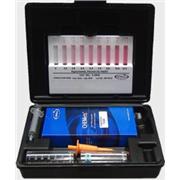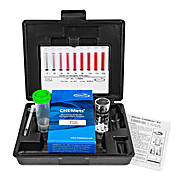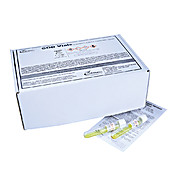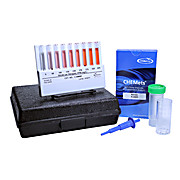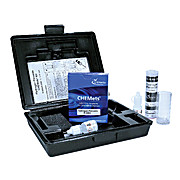CHEMetrics
-
 Dissolved Oxygen CHEMets® Kits
CHEMetrics
Dissolved Oxygen CHEMets® Kits
CHEMetricsThe level of dissolved oxygen in natural waters is often a direct indication of quality, since aquatic plants produce oxygen, while microorganisms generally consume it as they feed on pollutants. At low temperatures the solubility of oxygen is increased; during summer, saturation levels can be as…
-
Glycol CHEMets Kit
CHEMetricsEthylene glycol and propylene glycol are the primary ingredients in commercially-available antifreezes. They are used with various corrosion inhibitors to protect metal surfaces in cooling water systems. CHEMetrics glycol kits are used to monitor potable waters for glycol contamination…
-
Molybdate CHEMets Kit, Range: 2-24 ppm
CHEMetricsMolybdate is used throughout the industrial water treatment and power generation industries as a corrosion inhibitor in both open- and closed-loop cooling water systems. In solution, molybdate anions complex with oxidized iron to form a protective film of molybdate and ferric-oxide. Molybdate is…
-
Chlorine Dioxide CHEMets Kit
CHEMetricsChlorine dioxide is used as an oxidizing microbiocide in industrial cooling water treatment, the dairy industry, the meat industry, and many other food and beverage industry applications. It is used as a bleaching agent in the pulp and paper industry, and as a disinfectant in municipal water…
-
Iron is present in nature in the form of its oxides, or in combination with silicon or sulfur. The soluble iron content of surface waters rarely exceeds 1 mg/L, while ground waters often contain higher concentrations. The National Secondary Drinking Water Standard for iron is 0.3 mg/L, as iron…
-
Because of its strong oxidizing properties, chlorine is an excellent biocide used to treat potable waters, municipal wastes, and swimming pools. When used to treat potable water, chlorine helps alleviate the adverse effects of iron, manganese, ammonia, and sulfide. The Maximum Residual Disinfectant…
-
Chlorine Comparator
CHEMetricsThe CHEMetrics chlorine comparator is ideal for drinking water applications, by detecting the percentage of chlorine present in water. It is easy to use and ensures accurate testing.
-
Chromate (Hexavalent) CHEMets Kit
CHEMetricsHexavalent chromium salts are used in numerous industrial processes. They are also used extensively as corrosion inhibitors in open and closed cooling water systems. The Diphenylcarbazide Method References: APHA Standard Methods, 22nd ed., Method 3500-Cr B - 2009. ASTM D 1687-02,…
-
Nitrate Vacu-vials Kit, Range: 0-7.50 ppm
CHEMetricsNitrate is the most completely oxidized form of nitrogen. It is formed during the final stages of biological decomposition, either in wastewater treatment facilities or in natural water supplies. Low-level nitrate concentrations may be present in natural waters. However, a Maximum Contaminant Level…
-
COD Vials Kit
CHEMetricsRange: 0-15,000 ppm (HR+) Not USEPA Approved* Method: Dichromate Reactor Digestion Kit comes in a cardboard box and contains everything needed to perform up to 97 tests (except distilled water): 98 vials and instructions. All COD Kits require the use of a Digestor Block and the…
-
Silica Vacu-vials® Kits
CHEMetricsSilica (SiO2) is the oxide of silicon, the second most abundant element in the earth's crust. Silica is present as silicates in most natural waters. Typical concentrations lie between 1 and 30 mg/L. Higher concentrations may exist in brackish waters and brines. The silica content of…
-
Nitrate CHEMets Kit, Range: 0-225 ppm
CHEMetricsNitrate is the most completely oxidized form of nitrogen. It is formed during the final stages of biological decomposition, either in wastewater treatment facilities or in natural water supplies. Low-level nitrate concentrations may be present in natural waters. However, a Maximum Contaminant Level…
-
Peracetic Acid SAM Kit
CHEMetricsRange: 0-5.0 ppm Method: DPD SAM Kit comes in a plastic case and contains everything needed to perform 30 tests: K-7913 Vacu-vials Kit, SAM Photometer, light shield, 4AAA batteries, screwdriver, and instructions.
-
Ammonia Vacu-vials Kit, Range: 0-7.00 ppm
CHEMetricsLow-level ammonia nitrogen may be naturally present in water as a result of the biological decay of plant and animal matter. Higher concentrations in surface waters can indicate contamination from waste treatment facilities, raw sewage, industrial effluents (particularly from petroleum refineries),…
-
COD VIALS MERC FREE 98VIALS UN 1830
CHEMetricsKit comes in a cardboard box and contains everything needed to perform up to 97 tests (except distilled water): 98 vials and instruction book. Range: 0-15,000 ppm (HR+) Mercury Free Method: APHA Standard Methods, 23rd ed., Method 3500-Cu C-1999. All COD Kits require the use…
-
Kit comes in a plastic case and contains everything needed to perform 30 tests (except distilled water): Refill, Low and High Range Comparators, dilutor snapper cup, micro test tube, and instructions. Range: 0-1000 & 1000-10,000 ppm MDL: 100 ppm Method: Direct Nesslerization …
-
Sulfide Comparator
CHEMetricsThe CHEMetrics sulfide comparator is an ideal thing to have in any chemical laboratories, medicinal facilities or healthcare units for a wide range of applications such as scientific research and development.
-
Nitrite Titrets Kit, Range: 500-5000 ppm
CHEMetricsRange: 500-5000 ppm as NaNO2 MDL: 500 ppm Method: Ceric Sulfate Titrant with Ferroin Indicator Increments: 500, 550, 600, 650, 700, 750, 800, 900, 1000, 1250, 1500, 1750, 2000, 2500, 3500, 5000 ppm Kit comes in a cardboard box and contains everything needed to perform 30…
-
DEHA CHEMets Kit
CHEMetricsDissolved oxygen in boiler system water causes corrosion and pitting of metal surfaces, which can lead to boiler inefficiency, equipment failure, and system downtime. DEHA (N,N-Diethylhydroxylamine) is added to boiler system water as an oxygen scavenger to keep the dissolved oxygen levels as low as…
-
Hardness is a measure of the mineral content of water. Calcium and magnesium are the most common minerals that contribute to hardness. Hard water causes scaling in boilers and other industrial equipment, and diminishes the effectiveness of soaps and detergents. The EDTA Method (Total) …
-
Method Dissolved carbon dioxide (CO2) is naturally present as a result of animal respiration, the decay of organic matter, and the decomposition of certain minerals. It is the major source of acidity in unpolluted water samples. Surface waters typically contain less than 10 ppm…
-
Nitrate CHEMets Kit, Range: 0-675 ppm
CHEMetricsNitrate is the most completely oxidized form of nitrogen. It is formed during the final stages of biological decomposition, either in wastewater treatment facilities or in natural water supplies. Low-level nitrate concentrations may be present in natural waters. However, a Maximum Contaminant Level…
-
Ammonia Stabilizer Solution
CHEMetricsThe CHEMetrics ammonia stabilizer solution is an ideal thing to have in any chemical laboratories, medicinal facilities or healthcare units for a wide range of purposes such as scientific research and development.
-
Chloride Titrets® Test Kits
CHEMetricsChloride is the most common inorganic anion found in water and wastewater. The Maximum Secondary Contaminant Level for drinking water for chloride is 250 mg/L. Natural sources of salt are the ocean and various salt deposits above and below ground. Chloride is very corrosive to most metals in…
-
Ozone Vacu-vials Kit
CHEMetricsOzone is a strong oxidizing agent and is used as an alternative to chlorine as a biocide in the disinfection of drinking water. Ozone is used to remove odor, decolorize, and to control algae and other aquatic growths. Ozone is also used in various disinfectant and sterilization processes in…
-
Hydrogen peroxide is a strong oxidizing agent with a variety of uses. Applications include the treating of industrial effluents and domestic waste and serving as a disinfectant in aseptic packaging. For the food and beverage industry, CHEMetrics Hydrogen Peroxide CHEMets® and…
-
Because of its strong oxidizing properties, chlorine is an excellent biocide used to treat potable waters, municipal wastes, and swimming pools. When used to treat potable water, chlorine helps alleviate the adverse effects of iron, manganese, ammonia, and sulfide. The Maximum Residual Disinfectant…
-
Hydrogen peroxide is a strong oxidizing agent with a variety of uses. Applications include the treating of industrial effluents and domestic waste and serving as a disinfectant in aseptic packaging. For the food and beverage industry, CHEMetrics Hydrogen Peroxide CHEMets® and…
-
Manganese Vacu-vials Kit
CHEMetricsSurface and ground waters rarely contain more than 1 mg/L of soluble or suspended manganese. Manganese can act as an oxidizing or a reducing agent depending on its valence state. Manganese is also used in the manufacture of batteries and as an alloying metal in the manufacture of steel and…
-
Carbohydrazide CHEMets Kit
CHEMetricsCarbohydrazide is added to boiler system water as an oxygen scavenger to control corrosion. It is a safer alternative to hydrazine, which is toxic. Carbohydrazide reacts with oxygen at low temperatures and pressures. The products of the reaction are volatile and do not contribute dissolved solids…
-
Kit comes in a plastic case and contains everything needed to perform 30 tests (except distilled water): Refill, Low and High Range Comparators, dilutor snapper cup, micro test tube, and instructions. Range: 0-30 & 30-300 ppm MDL: 5 ppm Method: Direct Nesslerization …
-
The CHEMetrics® V-2000 Photometer is the most advanced portable microprocessor-based LED colorimeter on the market today. Packed with features, this portable water analyzer automatically tests pre-programmed (50+) analytes using CHEMetrics Vacu-vials® self-filling, pre-measured ampoules.…








